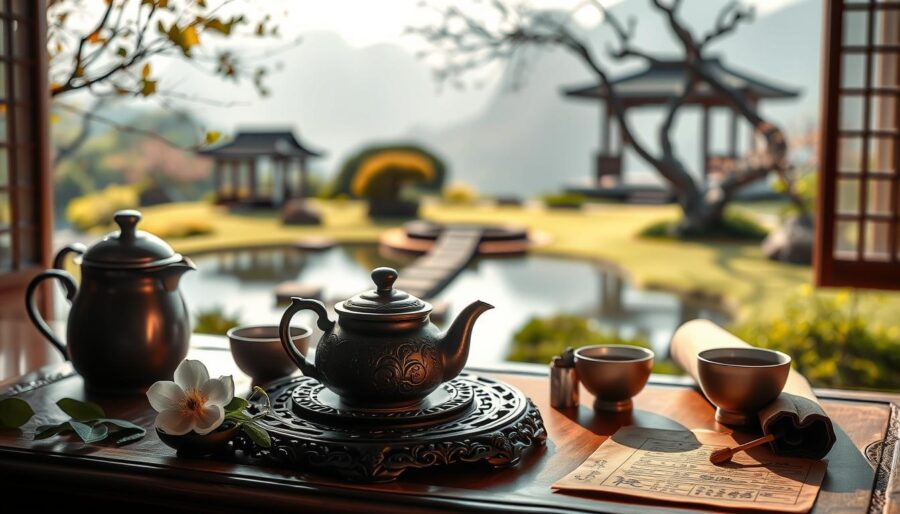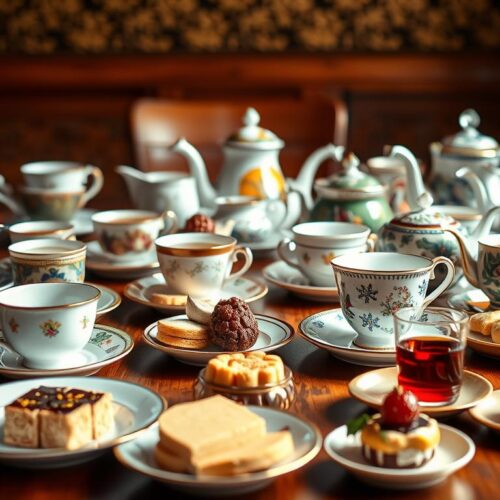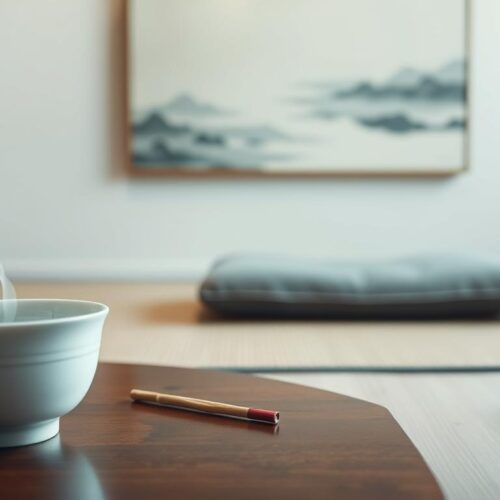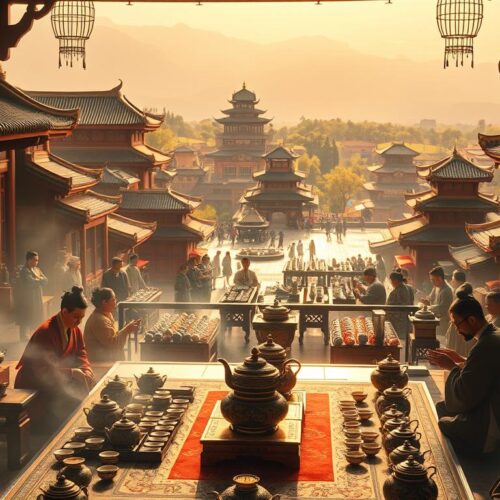On your tea journey, get ready to unlock tea’s rich symbolism. Tea isn’t just a drink; it’s a part of history, binding cultures together. As you explore tea history, you’ll see its role in social events and cultural rituals. This knowledge reveals how tea builds community and strengthens bonds between people.
The Cultural Significance of Tea
Tea is important in many cultures around the world. It’s more than a drink; it carries a rich history. Traditions and social customs are part of tea culture. This shows how tea fits into daily life and special moments.
In Japan, tea rituals focus on harmony and respect. The formal ceremonies highlight mindfulness and the beauty of nature.
In the West, tea helps people connect and talk more easily. Friends and family come together for tea, sharing stories and laughs. Tea is also key during big life events, like weddings or memorials, showing hospitality and kindness.
Tea rituals help us see how much people value tradition and connection. Whether it’s a formal ceremony or a laid-back tea party, each time tea is shared, it brings people together. This shows how important tea is to cultural heritage.
Colors and Flavors: What They Represent
Exploring tea shows a complex world of symbolism with colors and flavors. Every color tells a story, showing us feelings and messages. Green tea, for instance, means life and new beginnings. Its lively color and taste symbolize energy, making it loved by those looking for a fresh start.
Herbal infusions, on the other side, promote calm with their muted colors. These tones signal peace and a chance to relax, welcoming you to unwind.
The table below shows different teas and what they represent:
| Type of Tea | Color | Flavor Profile | Symbolic Meaning |
|---|---|---|---|
| Green Tea | Vibrant Green | Fresh, Grassy | Vitality, Renewal |
| Black Tea | Deep Amber | Robust, Bold | Strength, Confidence |
| Oolong Tea | Warm Gold | Floral, Fruity | Balance, Harmony |
| Herbal Tea | Earthy Tones | Floral, Spicy | Calm, Comfort |
| White Tea | Delicate Silver | Light, Sweet | Purity, Elegance |
Understanding tea’s colors and flavors deepens our love for it. Every drink tells a broader story, connecting us to tea’s history and our own stories in unique ways.
Tea Ceremonies: A Reflection of Values
Tea ceremonies are more than just traditions. They reflect deep values and beliefs found in different tea cultures. Each one shows us the value of staying in the moment, respecting nature, and the power of coming together. Whether it’s the precise steps in the Japanese tea ceremony or the shared moments in Chinese tea rituals, these customs teach us about simplicity and focus.
When you take part in a tea ceremony, you follow detailed actions that are rich in cultural meaning. Making tea involves graceful movements that stand for purity and peace. This process isn’t just about drinking tea. It’s about building an atmosphere of mutual respect and appreciation for the tea, the surroundings, and one another.
Take a look at this table to see how tea ceremonies differ across cultures:
| Ceremony | Culture | Core Values | Ritual Elements |
|---|---|---|---|
| Japanese Tea Ceremony | Japan | Mindfulness, Harmony | Tea preparation, Zen aesthetics |
| Chinese Tea Ceremony | China | Respect, Community | Elaborate serving, Family gatherings |
| English Afternoon Tea | England | Socialization, Elegance | Varied teas, Light snacks |
| Moroccan Mint Tea Ceremony | Morocco | Hospitality, Tradition | Layered mint infusion, Family sharing |
Exploring tea ceremonies opens our eyes to how these rituals share cultural values across the world. Through each ceremony, we learn about the beliefs that unite and define communities. It’s a glimpse into the diverse world of tea culture everywhere.
The Spiritual Connection of Tea
The journey into tea’s spiritual side shows a deep link with ourselves and our surroundings. Drinking tea mindfully turns it into a moment of meditation. It helps us become more aware of right now. This practice lets people feel calm and think deeply, uncovering the spiritual meanings behind tea symbolism.
Teas hold special places in spiritual rituals around the world. For example, Matcha is central to Japanese tea ceremonies, focusing on mindfulness and peace. Herbs like Chamomile and Lavender are loved for their soothing effects, used in rituals to bring spiritual clarity.
When we drink tea with attention, it’s a chance to explore ourselves. Each cup opens the door to more understanding, urging us to look into our thoughts and emotions. This ritual helps us connect to our inner selves while enjoying the tea’s taste and smell. Imagine the tea’s energy blending with yours, making the moment even more special.
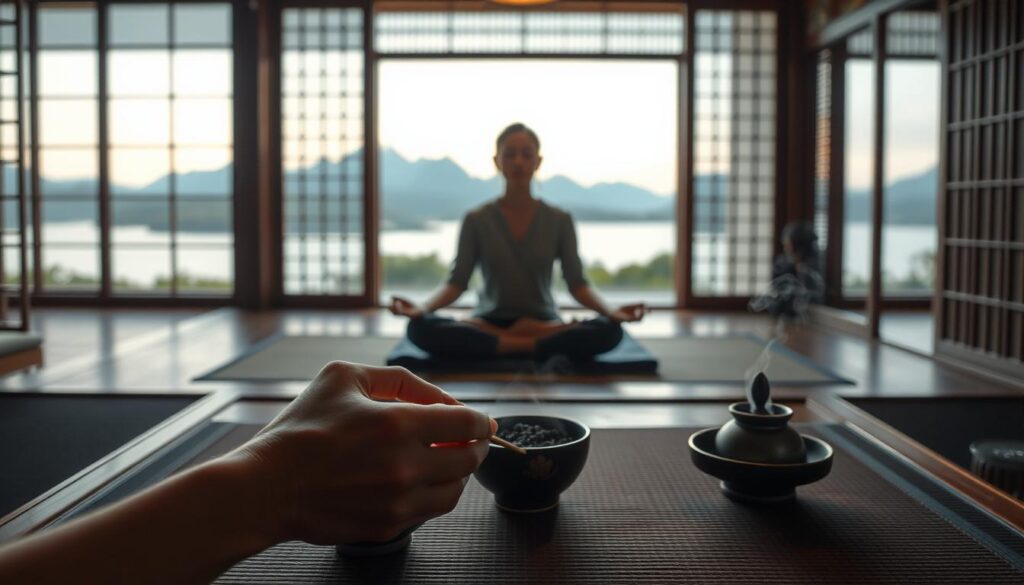
To dive deeper into tea’s spiritual symbolism, think about these points:
- Presence: Being mindful in making tea helps you appreciate the current moment more.
- Connection: Sharing tea can build strong relationships, showing how we’re all connected.
- Ritual: Doing this regularly gives you a sense of ritual, helping you in your spiritual path.
Understanding tea’s spiritual side not only makes you enjoy it more but also deepens your life experience. It celebrates life and awareness, brought out through the art of tea drinking.
Tea and Relationships: Building Bonds
Tea is key to growing relationships. It helps create and strengthen social bonds. Sharing tea breaks down barriers and brings an atmosphere of trust and warmth. This act helps build lasting friendships and stronger family ties.
Different cultures view tea time as important social events. They stand for community and togetherness. These gatherings allow for open talks and shared stories. A tea meeting is great for making deeper connections.
Tea drinking traditions can differ, but the core values are the same worldwide. It doesn’t matter if it’s a formal Asian tea ceremony or a casual tea time in a garden. The heart of tea culture is about connecting with others, promoting understanding and teamwork.
| Type of Tea Meeting | Social Connection Benefits |
|---|---|
| Informal Gatherings | Encourages casual conversation and laughter |
| Formal Ceremonies | Fosters respect and cultural appreciation |
| Community Events | Strengthens community ties and shared identity |
The Symbolism of Tea Ingredients
Learning about tea ingredients lets us see the deep symbolism in every blend. The ingredients chosen add unique flavors and carry cultural meanings. For example, jasmine is popular in many blends, showing beauty and elegance. This flower makes your tea a celebration, lifting the experience to new levels.
Peppermint is also a go-to ingredient, standing for purity and renewal. When it’s part of a blend, it refreshes your taste and spirit. Across cultures, peppermint tea symbolizes clear thoughts and new energy.
Below is a table that highlights some popular tea ingredients, their symbolic meanings, and the types of tea blends they typically enhance:
| Tea Ingredient | Symbolic Meaning | Common Tea Blends |
|---|---|---|
| Jasmine | Beauty and Elegance | Jasmine Green Tea, Jasmine Pearls |
| Peppermint | Purity and Rejuvenation | Peppermint Tea, Peppermint Green Tea |
| Chamomile | Calmness and Tranquility | Chamomile Tea, Herbal Blends |
| Ginger | Strength and Wellness | Ginger Tea, Spiced Tea Blends |
Knowing about tea ingredients and what they symbolize makes tea drinking richer. As you try out different teas, think about their meanings and the feelings they stir. This way, drinking tea becomes a meaningful ritual, beyond just enjoyment.
Seasonal Teas and Their Symbolic Meanings
Each season brings a unique set of teas with deep symbolism. In winter, spiced chai is popular. Its bold flavors provide comfort in the cold. This tea makes you feel warm and celebrates togetherness during winter festivities.
When spring comes, teas like jasmine or cherry blossom are favored. They symbolize renewal and growth, matching the lively changes in nature. Drinking these teas can lift your mood, showing how flavors affect your emotions.
Summer introduces refreshing iced teas, like hibiscus or mint. These drinks embrace the summer heat, boosting social time and relaxation. They symbolize rebirth and freedom, fitting summer vibes and outdoor fun.
Autumn is for earthy teas, like rooibos or pumpkin spice. These teas reflect harvest and thanks, urging you to think about abundance and comfort. Enjoying these flavors connects you with nature’s rhythms, increasing your seasonal gratitude.
The Environmental Symbolism of Tea
The link between tea and nature weaves a story filled with environmental meaning. It shows how important it is to care for our planet. Organic tea farming is a prime example of this care.
Choosing tea is more than enjoying a drink. It’s an act of valuing our world.
Tea plants need specific environments to grow well. This need highlights the deeper significance of sustainability and love for nature. The way we grow tea can teach us about protecting the environment.
By picking tea brands that focus on ethical and organic methods, you make a positive choice. This choice is good for your health and connects you deeply with nature. It shows you want to keep the earth safe for those who come after us.
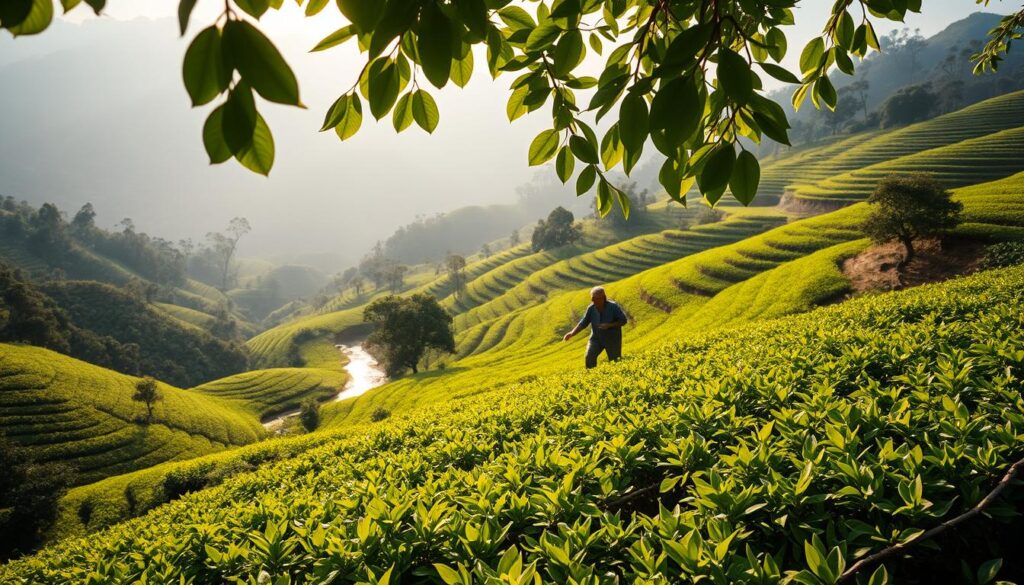
The Art of Tea Presentation
Tea presentation is more than a tradition; it’s a way to make each sip special. It shows culture and adds beauty to drinking tea. By using beautiful teacups and elegant teapots, you create a lovely setting that makes tea time more meaningful.
How you present tea matters a lot. It can show care and invite people to enjoy the moment. Placing snacks with your tea, for example, adds to the taste and look, making everything better.
Colors are key when serving tea. They can match the season or honor traditions. This mix of beauty and meaning deepens your connection to tea drinking.
Remember, every part of tea serving adds to the experience. Your choice of cups and how you set things up make tea time special for you and your friends.
Tea in Literature and Art
Tea is a powerful symbol in literature and art, standing for comfort, deep thought, and shared moments. It shows up during quiet and important times in stories and art, adding layers of emotion and cultural meaning. Through famous works, we see the many sides of tea, strengthening how characters connect with themselves and others.
In stories, tea often starts conversations and deep thinking. Authors like Virginia Woolf and Haruki Murakami use tea to mark moments of quiet and togetherness. This makes us think of old memories and feel like we belong somewhere.
Artists bring tea and art together in beautiful images and paintings that show what it means to enjoy tea. Claude Monet and Rachael Koo focus on tea in their work, setting it in peaceful and friendly scenes. These artworks make us love tea even more, not just as a drink but as a sign of life’s simple joys and friendships.
| Type of Representation | Example | Symbolism |
|---|---|---|
| Literature | Virginia Woolf’s “Mrs. Dalloway” | Reflection and connection |
| Art | Claude Monet’s “Tea Time” | Harmony and tranquility |
| Poetry | Emily Dickinson’s verses | Nostalgia and solitude |
| Photography | Rachael Koo’s food photography | Celebration of everyday moments |
Looking into tea symbolism in these forms shows us its big effect on culture and how we express feelings. Tea comes up again and again in literature and art, making us enjoy and understand the small but important parts of life more deeply.
Brewing Techniques: A Symbolic Ritual
The way we brew tea shows our culture and beliefs. Different brewing methods showcase patience, attention to detail, and being in the moment. Each style tells its own story in the journey of tea making.
Tea rituals turn a simple act into time for thought and pleasure. Picking the right temperature and how long to steep connects to these ideals. It highlights the delicate balance between water and tea leaves. This care brings out the best natural tastes and smells from the tea.
- Traditional Steeping: Use a teapot and loose leaves for full flavor.
- Cold Brew: A soft way that brings out the tea’s sweetness, no bitterness.
- Matcha Whisking: A special process that involves mind and body.
Each method does more than change the taste; it makes the tea drinking moment special. Taking part in these rituals makes you feel closer to the drink. It turns everyday tea drinking into a deep experience of calm and gratitude.
The Future of Tea Symbolism
Thinking about tea’s future, we see its symbolism changing in our connected world. Cultures are mixing faster, updating tea’s traditional values with new influences. The core of tea’s meaning is blending old traditions with today’s ways and values.
New brewing methods and exciting flavors are changing how we see tea. There’s more focus on being eco-friendly and healthy. This shift makes tea more than a drink—it’s a full experience. It makes us think about how future folks will see tea’s symbolism.
Even with changes, keeping tea’s real traditions is key. As cultures merge, we’re making a new tea story. But we must not forget its past. Balancing new ideas with old ones is crucial. It invites us to see how our tea rituals might change, while still cherishing their deep meanings.

